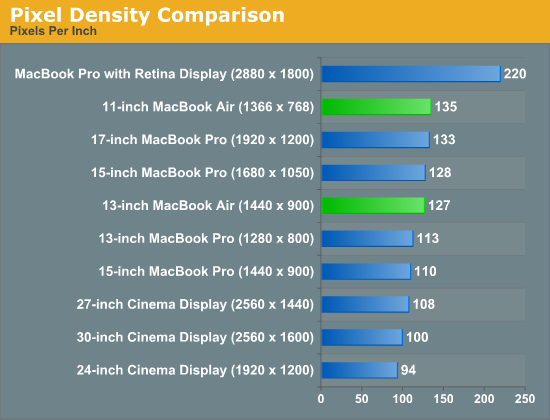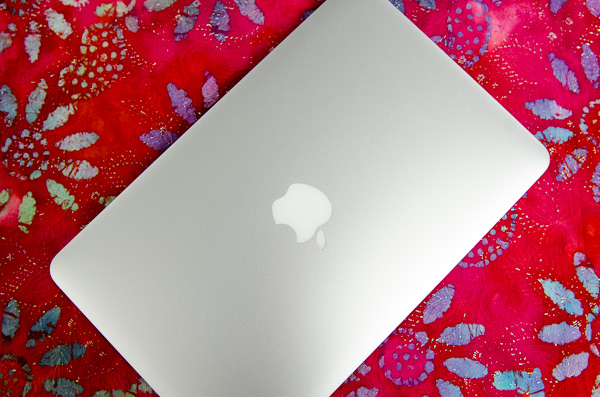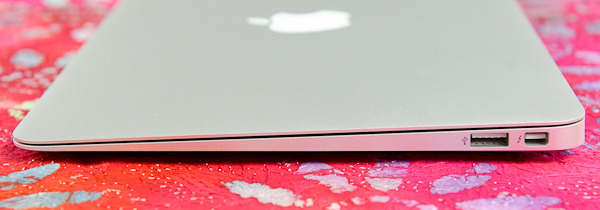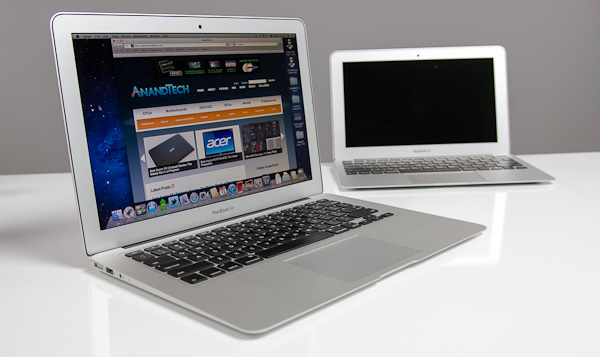The 2012 MacBook Air (11 & 13-inch) Review
by Anand Lal Shimpi on July 16, 2012 12:53 PM EST- Posted in
- Apple
- Mac
- MacBook Air
- Laptops
- Notebooks
Things are getting very blurry.
The MacBook Pro once stood for tons of power plus upgradability. Add a Retina Display and now it's just tons of power. It's a thicker, faster MacBook Air (with an awesome display). It's not bad, in fact it's quite amazing, but it confuses the general order of things.
The MacBook Air doesn't help in the clarity department. You can now order a MacBook Air with up to 8GB of RAM and a 512GB SSD, for the first time in MacBook Air history. Users who were once forced into Pro territory because of RAM and storage requirements can now happily live with an Air. And thanks to Turbo Boost, you do get similar performance in lightly threaded workloads.
Take a step away from the Mac world and you'll see the rest of the market is going through its own confusing period. Nearly every single Microsoft partner is mixing tablets and Ultrabooks. If your tablet uses smartphone hardware, and can dock into a notebook or Thunderbolt itself into a desktop, is all of this a lot of confusion before client computing moves entirely to smartphones? NVIDIA said it would happen publicly (even Intel did so privately a few years ago). Maybe it wasn't just convenient rhetoric. Maybe that's where we're headed. Until then, there are going to be a lot of different form factors, all with very compelling features. The MacBook Air continues to be one of them.
Despite the recent Ultrabook frenzy, the MacBook Air was one of the first (if not the first) to marry performance with usability, screen size/resolution, portability and battery life. Ultraportables prior to the MacBook Air's arrival in 2008 typically sacrificed in one or more of the above areas. I spent years in pursuit of the perfect ultraportable in college over a decade ago (30 is the new 20 right?), and generally came away disappointed and empty handed.
In 2010 Apple changed the expectations of cost with the MacBook Air. The new 11-inch model would start at just $999. And the 13-inch would only cost $300 more. The very first MacBook Air, by comparison, retailed for $1800. Apple took an ultraportable and made it its mainstream notebook. It was a bold move but one that was very forward looking.
Today the MacBook Air is even more affordable. The 11-inch model still starts at $999, but the 13-inch version is only $200 more. From the outside not a lot has changed, but that doesn't mean there's any less to talk about. Ivy Bridge, USB 3.0 and faster SSDs are all on the menu this year. Let's get to it.
The 11 & 13
Unlike the other thin member of Apple's Mac lineup, the MacBook Air chassis hasn't changed over the past three years. Since the 2010 update that gave us the 11-inch model and significantly lower prices, Apple has stuck with a design that only recently has seen widespread emulation.
While our last review focused on the beginning of a new generation, this review takes a look at a very mature, yet still very good design. The MacBook Air is just so pleasant to carry around. It'll make even the new rMBP feel like a pig.
Both the 11 and 13-inch models are effortless to carry around. While I dread traveling with a traditional notebook, slipping one of these into my backpack is barely noticeable. You can get used to and take for granted just about anything, but the form factor of the MacBook Air continues to be a favorite of mine even today.

The 11-inch MacBook Air is a great option for those who want the portability of a tablet but find themselves wanting to attach a keyboard to it most of the time. The 11.6-inch display boasts the highest pixel density of all of Apple's non-retina displays at 1366 x 768, but it's still quite usable. You don't make any sacrifices on keyboard size or key spacing (it's identical to the 13-inch model for the majority of the keys), nor do you have to give up any performance either. Apple offers all of the same CPU, memory and storage upgrades across both MacBook Airs. And with no discrete GPU, thermal throttling isn't really a problem either in the 11-inch chassis. With Thunderbolt, the 11-inch MacBook Air can actually give you the best of both worlds: an incredibly portable computer when you're on the go, and enough to act as your desktop when docked to a Thunderbolt Display.
I've traditionally always bought the 11-inch MacBook Air with the thought that I'd carry it when I didn't need to lug around my MacBook Pro. I seemed to be fooling myself however as over 90% of the time I'd end up with the MacBook Pro. The 11-inch Air was relegated to typewriter duty when I needed a change of scenery while writing at home. It's a great writer's companion, but if I couldn't have more than one system I'd have to opt for its bigger brother.
When I first reviewed the redesigned 13-inch MacBook Air I wrote that it felt more like a normal notebook, while the 11 was something a bit more unique. Perhaps I was more infatuated with the new 11 at the time, because these days I'm more drawn to the 13-inch MacBook Air as the notebook to have if you can only have one.
You get a 23.5% increase in screen resolution on a display that's just easier to look at. While 1440 x 900 is a bit much on a 15-inch MacBook Pro, I'd say it's near perfect on the 13-inch Air. If Apple were to do the Retina treatment on here, it'd be magnificent.
The larger chassis allows room for an SD card reader, which is thankfully quite functional. Otherwise the port layout is identical to the 11-inch model.
| 2012 MacBook Air Lineup | ||||||
| 11.6-inch | 11.6-inch (high-end) | 13.3-inch | 13.3-inch (high-end) | |||
| Dimensions |
H: 0.11-0.68" (0.3-1.7cm) W: 11.8" (30cm) D: 7.56" (19.2cm) |
H: 0.11-0.68" (0.3-1.7cm) W: 12.8" (32.5cm) D: 8.94" (22.7cm) |
||||
| Weight | 2.38 lbs (1.08kg) | 2.96 lbs (1.35kg) | ||||
| Cores/Threads | 1.7GHz dual-core Core i5 | 1.8GHz dual-core Core i5 | ||||
| Base Clock Speed | Intel HD 4000 | |||||
| RAM | 4GB DDR3L-1600 | |||||
| SSD | 64GB SSD | 128GB SSD | 128GB SSD | 256GB SSD | ||
| Display Resolution | 1366 x 768 | 1440 x 900 | ||||
| Ports | Thunderbolt, 2x USB 3.0, headphone jack | Thunderbolt, 2x USB 3.0, SD card slot, headphone jack | ||||
| Price | $999 | $1099 | $1199 | $1499 | ||
In its role as a proponent of simplicity, Apple has reduced the decision between what Air to get down to screen size, resolution and battery life (the 13-inch chassis houses a much larger battery). If you like having more of all of those things, the 13-inch Air is for you. If carrying anything larger than a tablet upsets you, buy the 11.




















190 Comments
View All Comments
LuckyKnight - Monday, July 16, 2012 - link
I've contemplated a MBA for some time - however I wish they would make a MacBook Pro 13" with dedicated graphics like the ASUS UX32VD.The MBA only has 1 thunderbolt connector, which means there's no cheap way of connecting my existing DVI monitor, HDMI to my TV and gigabit ethernet all at the same time (if that is possible at all).
The MBA also presumably suffers from the 23.967Hz bug as it uses Intel graphics. So it's use as a XBMC client is reduced for me.
I don't want a 15" model any more. This is just too big for me.
The MBA is a very nice product. I would consider the ASUS if they keyboard didn't bend? and it was available in the UK! Despite the faults, still considering it.
If ASUS were to resolve their issues I would probably get that however.
Elwe - Tuesday, July 17, 2012 - link
"The MBA only has 1 thunderbolt connector, which means there's no cheap way of connecting my existing DVI monitor, HDMI to my TV and gigabit ethernet all at the same time (if that is possible at all)."This is true. But you do have a couple of options. One is to use the Apple USB to Ethernet Adapter (http://store.apple.com/us_smb_78313/product/MC704Z... It was made for prior years' models, and it will only 10/100Mb/s. Not anywhere close to ideal, but there it is.
Your other options is to wait and see if something with the ASIX AX88179 chip (or some such) gets released (http://www.asix.com.tw/products.php?op=pItemdetail... I guess USB 3.0 to GigE is not really desired by the market (I guess because most people are either already in a tower and so have other options or are fully OK with wireless).
In this form factor, one has to ask how many high-speed sports are realistic . . . Three? If so, perhaps they have it right (two USB 3.0 and one Thunderbolt given how much people have been screaming for USB 3.0). Or perhaps it should be the other way (I think I would personally rather have the two Thunderbolt and do use either an adapter from Thunderbolt or a USB hub when I need two or more USB ports). Four? Well, I am not sure I know of any Ultrabooks that that this configuration but it would be nice.
reactor - Monday, July 16, 2012 - link
I have a previous gen MBA and tried out the new one in store. Not nearly enough of a leap for me to think about upgrading. Hopefully Haswell comes through with the supposed GPU bump(and maybe, hopefully, a retina display), my old MBA handles everything I need it to do except graphics heavy things and I like the form factor too much to go up to the 15" retina.KPOM - Monday, July 16, 2012 - link
Ivy Bridge is the "tick" part of the tick-tock cycle. It is a small upgrade to the CPU, though the GPU is a bit more of an improvement. Consider that in 2011, Apple switched to the Sandy Bridge from the 5 year-old Core 2 processor. I don't think the 2012 is aimed at 2011 owners as much as it is 2010 and earlier owners, as well as those new to the platform.mastertoller - Monday, July 16, 2012 - link
well with the 2x faster SSD, 8gb ram option, it makes up for it.ltcommanderdata - Monday, July 16, 2012 - link
Great review. How's OpenCL performance like on the HD4000 since that was a sore point with Sandy Bridge that Ivy Bridge corrects? A comparison between the HD4000, 320M and an older discrete GPU like a 330M GT or 6490M would be informative.You've consistently noted in your reviews that Apple's desires for smaller enclosures, GPGPU, and smaller displays are constrained by GPU hardware, particularly from Intel. With Mountain Lion's upcoming release, I wonder if you'll consider examining the software side of things to see how much effort has been put into the GPU drivers and whether they are now up to par with Windows GPU drivers? Once they are released, perhaps a comparison between 10.7.5, 10.8, and Windows 7 with the best recent GPUs from each vendor (Intel HD4000, nVidia GT 650M, AMD 6970M) and one example of an older GPU that still supports OpenCL (nVidia 8xxx/9xxx or ATI HD4xxx) to see if all Macs are seeing development effort or only recent ones. Ideally the benchmarks would not only be games (Portal 2, SC2, Civ V, and a non-Source Engine shooter or two like Deus Ex Human Revolution or Bioshock 2), but also OpenGL accelerated applications (such as Cinebench and Photoshop) and OpenCL accelerated applications (the new OpenCL Photoshop CS5 filters).
De_Com - Monday, July 16, 2012 - link
As a long time reader of AT, I must say how nauseating it has become to read any Apple reviews nowadays, especially Anand's.I believe all objectivity has gone out the window, and that someone else should be given a crack at reviewing Apple products. Both Brian and Dustin have done some cracking reviews lately and I'd like one of these guys to be given a shot at reviewing the next Apple laptop.
Reading the words "awesome", "amazing","infatuated", "it just works"...etc, the reviews have morphed into what seems like some weird sales pitch, seriously am I the only one to notice this?
You'd be hard pressed telling this review apart from the sales blurb direct from the Apple website.
Whenever there's a bad word to be said, like f/f camera, wifi, there are immediate excuses made overlooking them. The camera is crap, unless you've excellent lighting, again glossed over with "well the software is easy and starts quickly". I could go on.
Don't wanna overgripe the situation, most reviews are excellent and well informed, but Anand's Apple reviews have just got so lopsided lately that they have become hard to stomach.
Please try and bring back the objectivity, it's what brought me here in the first place.
KPOM - Monday, July 16, 2012 - link
"As the MacBook Air retains its TN display, for the first time we can actually say that ASUS' Ultrabook offers better viewing angles than the Air. The difference is quite noticeable: ...There's no denying that what ASUS has done is better,"
Yeah, Anand NEVER acknowledges when other products are better than Apple.
De_Com - Monday, July 16, 2012 - link
"The MacBook Air is no longer competing against poorly designed netbooks, but a bunch of clones that are quickly approaching parity across the board. The MBA panel isn't bad, but it needs to be better.Even without a new display however, the MacBook Air continues to be one of the best executed ultraportables on the market today"
Your missing the point, being objective is taking similar products, stepping back and reviewing both in an unbiased way. Never did I accuse Anand of not acknowledging other good products, however I did accuse him of making a bad point followed by glossing over it with a good one, and you sir have made my point for me.
KPOM - Monday, July 16, 2012 - link
On the whole, it IS still one of the best executed ultraportables on the market today. I have seen other ultraportables, and the only ones that I have seen that come close or exceed the Air are the Samsung 9 series and the ASUS Zenbook. They are also priced similarly.Anand's review of the 2011 was far more glowing. This was an evolutionary update, and so the difference isn't as stark, and the display is starting to become more ordinary. However, the rest of the machine is still very good.
Being objective sometimes means praising a product.